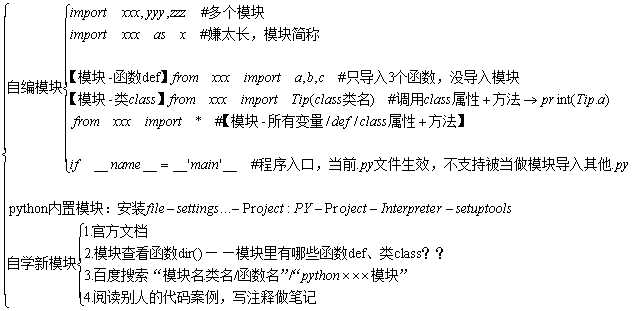标签:width rom 基本用法 png elf 内容 运行 port mic
模块常用语句 import x(下面红色框内就是test.py模块,import就是在main.py里调用test.py)

if __name__ == ‘__main__‘ 下的程序,指定 Python 模拟环境的程序入口(当前正在运行的.py文件),只在当前运行的.py文件生效,
不支持被导入其他.py文件中。Python 本身并没有规定这么写,这是一种程序员达成共识的编码习惯。

1 # 1.举例子 2 ## 文件【main.py】 3 import test # 导入test模块 4 print(test.a) # 使用test模块-a属性 5 test.hi() # 使用test模块-hi方法 6 7 print(test.Go1.a) # 使用test模块-Go1类-a属性 8 test.Go1.do1() # 使用test模块-Go1类-do1方法 9 10 A = test.Go2() # 使用test模块-Go1类,进行实例化 11 print(A.a) # 实例化后,不再需要“模块.” 12 A.do2() # 实例化后,不再需要“模块.”
## 文件【test.py】
a = ‘我是模块中的变量a‘
def hi():
a = ‘我是函数里的变量a‘
print(‘函数“hi”已经运行!‘)
class Go1:
# 如果没有继承的类,class语句中可以省略括号,但定义函数的def语句括号不能省
a = ‘我是类1中的变量a‘
@classmethod
def do1(cls):
print(‘函数“do1”已经运行!‘)
class Go2:
a = ‘我是类2中的变量a‘
def do2(self):
print(‘函数“do2”已经运行!‘)
print(a) # 打印变量“a”
hi() # 调用函数“hi”
print(Go1.a) # 打印类属性“a”
Go1.do1() # 调用类方法“Go1”
A = Go2() # 实例化“Go2”类
print(A.a) # 打印实例属性“a”
A.do2() # 调用实例方法“do2”
1 # 2. 【庙里有个老和尚】 2 # 文件【main.py】 3 import story as s # 嫌story太长,取个简称s 4 # import test,story # 同时导入test模块,story模块 5 for i in range(10): 6 print(s.sentence) # story模块-sentence变量 7 print(s.Temple.sentence) # story模块-Temple类-sentence属性 8 s.Temple.reading() # story模块-Temple类-reading()方法 9 # s.mountain # story模块-函数def 10 from story import mountain # 【模块-函数def】mountain()不用加s. 11 mountain() 12 # from story import * # 导入模块中任何变量/函数/类方法+属性 13 # from story import a,b,c # 同时导入story模块-多个函数def 14 A = s.Story() # 实例化,之后就不用加‘story.’ 15 print(A.sentence) 16 A.reading() 17 18 # 文件【story.py】 19 sentence = ‘从前有座山,‘ 20 def mountain(): 21 print(‘山里有座庙,‘) 22 class Temple: 23 sentence = ‘庙里有个老和尚,‘ 24 @classmethod 25 def reading(cls): 26 print(‘在讲故事,‘) 27 class Story: 28 sentence = ‘一个长长的故事。‘ 29 def reading(self): 30 print(‘讲的什么故事呢?‘)
1 ### 3 【程序入口】,一种共识if __name__==__‘main‘__ 2 # 文件【main.py】 3 import story 4 ## 因为story.py里面有if __name__==__‘main‘__ 5 ## 它包含的内容只在story.py运行,在main.py不能被用 6 7 # 文件【story.py】 8 sentence = ‘从前有座山,‘ 9 def mountain(): 10 print(‘山里有座庙,‘) 11 class Temple: 12 sentence = ‘庙里有个老和尚,‘ 13 @classmethod 14 def reading(cls): 15 print(‘在讲故事,‘) 16 class Story: 17 sentence = ‘一个长长的故事。‘ 18 def reading(self): 19 print(‘讲的什么故事呢?‘) 20 ## 下面的内容只能在story.py中运行 21 ## 不能被当做模块导入main.py文件 22 if __name__ == ‘__main__‘: 23 print(sentence) 24 mountain() 25 print(Temple.sentence) 26 Temple.reading() 27 A = Story() 28 print(A.sentence) 29 A.reading() 30 print()
基本用法:6《学习模块.py :<类class /函数def>》
标签:width rom 基本用法 png elf 内容 运行 port mic
原文地址:https://www.cnblogs.com/lj-attitudes0303/p/10354649.html